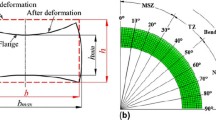Abstract
Ridged rectangular tubes are widely utilized in microwave equipment as waveguides. However, cross-sectional deformation easily occurs when a ridged rectangular tube is bent. Especially for H-typed bending, the deformation of ridge grooves cannot be controlled effectively by using the current bending tools. Therefore, a novel method adding fillers in ridge grooves to reduce the distortion is presented in this paper. According to this method, a three-dimensional finite element model of H-typed rotary draw bending of H96 brass double-ridged rectangular tube with ridge groove fillers was established, and then the reliability of the model and new method was verified by the experiment. It is found that when fillers are used, cross-sectional deformation significantly decreases, especially the height deformation and the spacing deformation of ridge grooves. Moreover, an obvious decrease in the distortion difference between different sections is observed, which means the distribution of deformation ratios along the bending direction is more uniform. Through further validation with a single-ridged rectangular tube, it shows that the novel method is feasible and ridge groove fillers are strongly recommended to be introduced in the bending of different ridged rectangular tubes.


















Similar content being viewed by others
References
Qiu D, Klymyshyn DM, Pramanick P (2002) Ridged waveguide structures with improved fundamental mode cutoff wavelength and bandwidth characteristics. Int J RF Microw C E 12(2):190–197
Trana K (2002) Finite element simulation of the tube hydroforming processes - bending, performing and hydroforming. J Mater Process Technol 127:401–408
Welo T, Paulsen T, Brobak TJ (1994) The behaviour of thin-walled aluminium alloy profiles in rotary draw bending—a comparison between numerical and experimental results. J Mater Process Technol 45:173–180
Miller JE, Kyriakides S, Bastard AH (2001) On bend-stretch forming of aluminum extruded tubes-I: experiments. Int J Mech Sci 43:1283–1317
Miller JE, Kyriakides S (2003) Three-dimensional effects of the bend-stretch forming of aluminum tubes. Int J Mech Sci 45:115–140
Lăzărescu L (2013) Effect of internal fluid pressure on quality of aluminum alloy tube in rotary draw bending. Int J Adv Manuf Technol 64:85–91
Baudin S, Ray P, Donald BJM (2004) Development of a novel method of tube bending using finite element simulation. J Mater Process Technol 153(22):128–133
Sedighi M, Kahnamouei JT (2014) Role of filling material on defects of thin-walled tube bending process. J Thero App Mech-pol 52(1):227–233
Utsumi N, Sakaki S (2002) Countermeasures against undesirable phenomena in the draw-bending process for extruded square tubes. J Mater Process Technol 123:264–269
Xiao YH, Liu YL, Yang H (2014) Research on cross-sectional deformation of double-ridged rectangular tube during H-typed rotary draw bending process. Int J Adv Manuf Technol 73(9-12):1789–1798
Liu CM, Liu YL, Yang H (2016) Influence of different mandrels on cross-sectional deformation of the double-ridge rectangular tube in rotary draw bending process. Int J Adv Manuf Technol 91(1-4):1243–1254
Liu CM, Liu YL, Ren JH, Yang H (2015) Influence of die constraint on cross-sectional deformation of H96 brass double-ridged rectangular Tube in E-typed rotary draw bending Process. Acta Aeronautica et Astronautica Sinica 36(4):1320–1329 (in Chinese)
Zhu YX, Liu YL, Li HP, Yang H (2013) Comparison between the effects of PVC mandrel and mandrel-cores die on the forming quality of bending rectangular H96 tube. Int J Mech Sci 76:132–143
Funding
The authors received financial support from the Science, Technology and Innovation Commission of Shenzhen Municipality (Grant No. JCYJ20170306160003433) and the National Natural Science Foundation of China (Grant No. 51375392).
Author information
Authors and Affiliations
Corresponding author
Additional information
Publisher’s note
Springer Nature remains neutral with regard to jurisdictional claims in published maps and institutional affiliations.
Rights and permissions
About this article
Cite this article
Liu, C., Liu, Y. & Sun, H. A novel method to reduce the distortion of ridged rectangular tube in H-typed rotary draw bending. Int J Adv Manuf Technol 104, 2149–2161 (2019). https://doi.org/10.1007/s00170-019-04042-0
Received:
Accepted:
Published:
Issue Date:
DOI: https://doi.org/10.1007/s00170-019-04042-0



